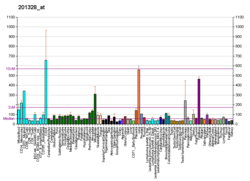ETS2
La protéine C-ets-2 (V-ets erythroblastosis virus E26 oncogene homolog 2 (avian) ou ETS2) est une protéine codée chez l'humain par le gène ETS2[5],[6] situé sur le chromosome 21 humain. La protéine codée par ce gène appartient à la famille des facteurs de transcription ETS[5].
Interactions[modifier | modifier le code]
La protéine ETS2 s'est montrée être capable d'interagir avec :
Notes et références[modifier | modifier le code]
- GRCh38: Ensembl release 89: ENSG00000157557 - Ensembl, May 2017
- GRCm38: Ensembl release 89: ENSMUSG00000022895 - Ensembl, May 2017
- « Publications PubMed pour l'Homme », sur National Center for Biotechnology Information, U.S. National Library of Medicine
- « Publications PubMed pour la Souris », sur National Center for Biotechnology Information, U.S. National Library of Medicine
- (en) Dwyer J, Li H, Xu D, Liu JP, « Transcriptional regulation of telomerase activity: roles of the the Ets transcription factor family », Ann N Y Acad Sci, vol. 1114, , p. 36–47 (PMID 17986575, DOI 10.1196/annals.1396.022).
- (en) « Entrez Gene: ETS2 V-ets erythroblastosis virus E26 oncogene homolog 2 (avian) », sur ncbi.nlm.nih.gov.
- (en) Guo Wei, « Ets-2 interacts with co-repressor BS69 to repress target gene expression », Anticancer Res., vol. 23, no 3A, , p. 2173–2178 (ISSN 0250-7005, PMID 12894593) :
.« yes »
- (en) J P Basuyaux, « The Ets transcription factors interact with each other and with the c-Fos/c-Jun complex via distinct protein domains in a DNA-dependent and -independent manner », J. Biol. Chem., vol. 272, no 42, , p. 26188–26195 (ISSN 0021-9258, PMID 9334186) :
.« yes »
- (en) M Kasten, « Cdk10, a Cdc2-related kinase, associates with the Ets2 transcription factor and modulates its transactivation activity », Oncogene, vol. 20, no 15, , p. 1832–1838 (ISSN 0950-9232, PMID 11313931, DOI 10.1038/sj.onc.1204295) :
.« yes »








